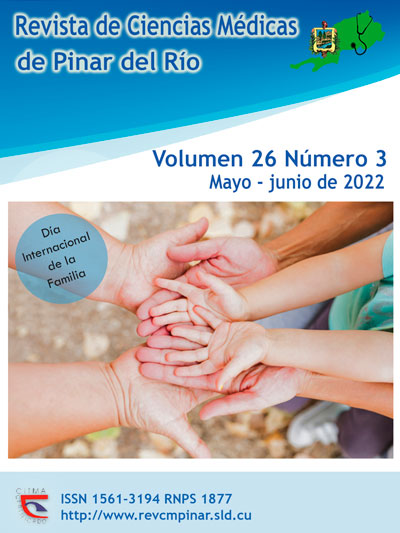Quality of lectures: an instrument for their evaluation
Keywords:
CONFERENCE, GUIDELINE, QUALITY, TEACHING, LEARNING, EDUCATION, MEDICAL.Abstract
Introduction: the evaluation of lectures can contribute to improve the quality of lessons.
Objective: to design an instrument for the evaluation of lectures in Medicine major.
Methods: a two-phase research was carried out: in the first phase, the instrument was designed based on the use of theoretical and empirical methods. In the second, by means of a cross-sectional descriptive study, the validity of the guide was evaluated. It was used in a sample of 90 lectures randomly chosen from the Medicine, Dentistry and Nursing majors taught at Dr. Agostinho Neto Hospital during 2017.
Results: an observation guide is designed comprising indicators that structure the dimensions: organizational and hygienic-sanitary conditions of the classroom, quality of the introduction, development and conclusions of the lectures. The relevance of the instrument to evaluate the quality of the lectures is demonstrated: insufficiencies in the use of blackboard 68,6 %; slides with deficient quality 62,8 %; no orientation of independent work 54,3 %.
Conclusions: the instrument can be contextualized in all the profiles of medical education and contributes to the objectivity in the comparison of results of the different verifications, it facilitates the understanding of studies to evaluate the evolution of the quality of the teaching-learning process, it also allows assigning priorities by the teaching department of the center for the training of professors, as well as evaluating the impact of the programs of pedagogical training for the teaching staff.
Downloads
References
1. Sizalima-Cuenca SM, Vásquez-Mena AE, Maldonado-Vélez BT, Ávila-Sánchez DE. La calidad de la clase como eje articular en el rendimiento académico. Rev OLIMPIA. [Internet]. 2017(citado 10/06/2021); 14(45): 252-266. Disponible en https://revistas.udg.co.cu/index.php/olimpia/article/view/855
2. González Halcones MA, Pérez González N. La evaluación del proceso enseñanza aprendizaje. Fundamentos básicos; 2004 [citado 07/06/2021]. Disponible en https://ruidera.uclm.es/xmlui/handle/10578/7951
3. Navarro Mosquera NG, Falconí Asanza AV, Espinoza Cordero J. El mejoramiento del proceso de evaluación de los estudiantes de la educación básica. Universidad y Sociedad. 2017 [citado 07/05/2021]; 9(4): 58-69. Disponible en http://scielo.sld.cu/scielo.php?script=sci_arttext&pid=S2218-36202017000400008&lng=es&tlng=es
4. Díaz Martell Y, Pérez Quiñones JA, Moure Ibarra M, Pérez Padrón A, Mayor Hernández F, Mella Herrera L. Esencialidades de la evaluación del aprendizaje en el proceso docente-educativo. Rev.Med.Electrón. [Internet]. 2017 Jun [citado 07/05/2021]; 39(3): 620-629. Disponible en: http://scielo.sld.cu/scielo.php?script=sci_arttext&pid=S1684-18242017000300022&lng=es
5. Cárreras Barnés J, Fenoll-Brunet MR. Guía para la evaluación de competencias en Medicina Universitari de Catalunya España, 2009 [citado 20/04/2021].Disponible en https://1library.co/document/q06pe2xq-guia-para-la-evaluacion-de-competencias-titulacion-medicina.html
6. República de Colombia. Ministerio de Educación Nacional. Modelo de pauta de observación en clase; 2002 [citado 20/04/2021]. Disponible en: https://www.mineducacion.gov.co
7. Calderón Méndez D. Guía de observación para profesores en formación. Ministerio de Cultura y Educación. Dirección de Educación Superior; 2016 [citado 20/04/2021]. Disponible en https://des-for.infd.edu.ar/sitio/wp-content/uploads/2020/05/GUIA-DE-OBSERVACI%C3%93N-PARA-PROFESORES-EN-FORMACI%C3%93N.pdf
8. Santos Smith K, Bravo Hernández PL. Propuesta de guía de observación para el ejercicio práctico estatal de la Licenciatura en enfermería. Educ Med Super[Internet]. 2017 [citado 07/05/2021]; 32(4). Disponible en http://scielo.sld.cu/pdf/ems/v31n4/a05-1076.pdf
9. Taboada Fernández BM, Aguilar Valdés J. Texto básico de salud escolar. Editorial Pueblo y Educación. La Habana. Cuba; 2005. p.48-49 [citado 10/01/2021].
10. Arenas Gutiérrez R, García Hernández K, Palacios Fernández L, Díaz Chieng LY, Pérez Planes D, Fernández Hernández RL. Técnicas para mejorar presentación en formato electrónico [Internet]. 2009 [citado 20/02/2021]; 63(3). Disponible en http://www.revinfcientifica.sld.cu/index.php/ric/article/view/1253
11. Rizo Rodríguez RR, Savigne Figueredo A, Rodríguez Fernández Z. La conferencia como forma de organización del proceso de enseñanza aprendizaje en la educación médica superior cubana. Educ Med Super[Internet]. 2018 [citado 05/06/2021]; 32(2). Disponible en http://scielo.sld.cu/scielo.php?script=sci_arttext&pid=S0864-21412018000200023&lng=es&nrm=iso
12. López Pérez R, Pérez Pérez de Prado N, López Pérez G. El pizarrón, la influencia de su uso en la calidad del proceso de enseñanza aprendizaje. Rev EDUMECENTRO [Internet]. 2012 Dic [citado 05/06/2021]; 4(3): 206-215. Disponible en:http://scielo.sld.cu/scielo.php?script=sci_arttext&pid=S2077-28742012000300021&lng=es.
13. Plan LEA. Cómo hacer un cierre simple pero efectivo al final de tus clases; 2019. Disponible en https://planlea.listindiario.com/2019/03/como-hacer-un-cierre-simple-pero-efectivo-al-final-de-tus-clases/
14. García Batista G, El trabajo independiente. Sus formas de realización. Editorial Pueblo y Educación. La Habana. Cuba; 2005 [citado 05/06/2021].
15. Mejía Gallegos CG, Michalón Acosta RA, Michalón Dueñas DE. El trabajo independiente: Su importancia en la calidad del proceso enseñanza-aprendizaje de la carrera de Odontología. Universidad y Sociedad[Internet]. 2017 [citado 07/06/2021]; 9(2): 28-36. Disponible en http://scielo.sld.cu/scielo.php?script=sci_arttext&pid=S2218-36202017000200003&lng=es&tlng=es
Downloads
Published
How to Cite
Issue
Section
License
Authors who have publications with this journal agree to the following terms: Authors will retain their copyrights and grant the journal the right of first publication of their work, which will be publication of their work, which will be simultaneously subject to the Creative Commons Attribution License (CC-BY-NC 4.0) that allows third parties to share the work as long as its author and first publication in this journal are indicated.
Authors may adopt other non-exclusive license agreements for distribution of the published version of the work (e.g.: deposit it in an institutional telematic archive or publish it in a volume). Likewise, and according to the recommendations of the Medical Sciences Editorial (ECIMED), authors must declare in each article their contribution according to the CRediT taxonomy (contributor roles). This taxonomy includes 14 roles, which can be used to represent the tasks typically performed by contributors in scientific academic production. It should be consulted in monograph) whenever initial publication in this journal is indicated. Authors are allowed and encouraged to disseminate their work through the Internet (e.g., in institutional telematic archives or on their web page) before and during the submission process, which may produce interesting exchanges and increase citations of the published work. (See The effect of open access). https://casrai.org/credit/



